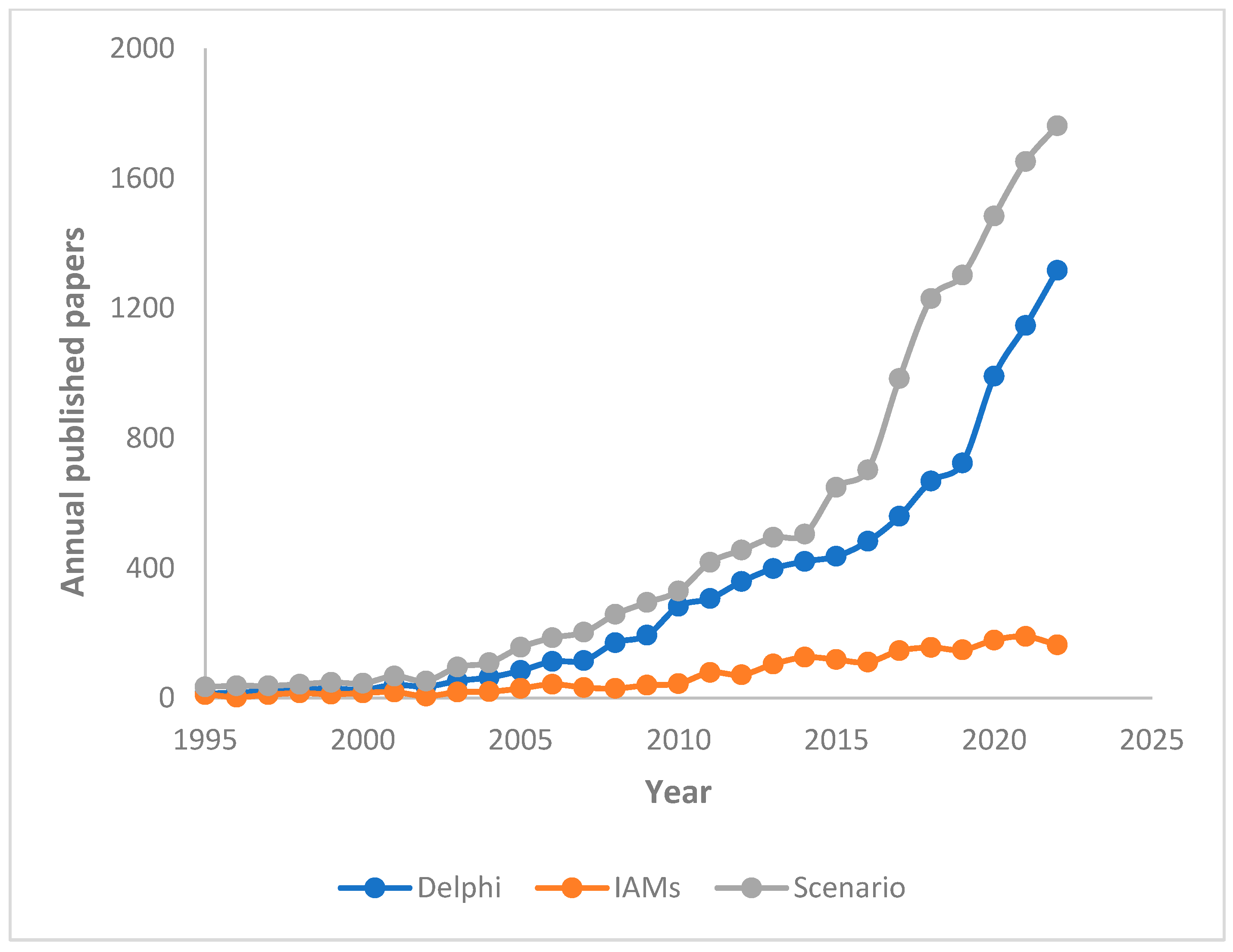Humans have always wanted to know what the future holds in store for them. In earlier centuries, people often sought clues to the future from sacred texts. Today, more secular approaches are increasingly used, although the older approaches to the future persist. Modern methods for prediction include trend extrapolation, the Delphi method, mathematical modeling, and scenario analysis, including backcasting. Extrapolation was only possible when reliable past data became available. The Delphi method relies on the judgement of experts in the subject matter. Mathematical modeling has been very successful in the physical sciences, and, in the form of integrated assessment models (IAMs), has been applied to problems such as assessing future energy use. Scenario analysis looks at a number of possible futures and develops internally consistent story lines around each. It is often used in conjunction with IAMs. Each of the four methods, including both their strengths and weaknesses, are discussed in turn. Finally, this entry looks at the future of prediction, and concludes that despite progress in each of the four approaches treated, predicting the future, never easy, is now harder than ever.
- Delphi method
- trend extrapolation
- future
- prediction methods assessment
- mathematical modeling
- scenarios

An obstacle for forecasting by any approach, particularly in the social sciences, is the existence of self-fulfilling and self-negating forecasts [13]. The classic example of the former is if the likelihood of a bank failure becomes general knowledge. A subsequent run on the bank will make failure more probable. A modern example comes from the UK. Under the ‘predict and provide’ model, road interests forecast high levels of future traffic, which were used to justify ambitious road construction programs. The additional road space induced more traffic [14]. An example of a self-negating prediction is when warning of a disease outbreak causes the public to take precautionary measures such as vaccination, which can greatly lessen infection rates. Today, there is such a plethora of scenarios to choose from, especially on the topics of future energy and climate change, that it is doubtful if they will lead to either self-fulfilling or self-negating forecasts. Yet nearly all but a few scenarios forecast continued economic growth, and both the public and policy makers act as if economic growth can continue indefinitely.
The main findings are that improvements have been made in each of the four approaches dmentiscussoned. At the same time, the rapid changes in both the biophysical and the socioeconomic worlds have made forecasting the future far more difficult. Nevertheless, despite these difficulties, we must attempt to forecast the future, even if we must abandon long-term forecasts; we have no alternative.References
- Polak, F. The Image of the Future; Elsevier Scientific Publishing Company: London, UK, 1973.
- Toffler, A. Future Shock; Random House: New York, NY, USA, 1970.
- Naisbitt, J. Megtrends: Ten New Directions Transforming Our Lives; Warner Books: New York, NY, USA, 1984.
- Wikipedia. Predictions and claims for the Second Coming. 2022. Available online: https://en.wikipedia.org/wiki/Predictions_and_claims_for_the_Second_Coming (accessed on 11 March 2023).
- Leoni, E. Nostradamus and His Prophecies; Dover Publications: New York, NY, USA, 2000. Fast Company. Timeline of Failed Predictions (Part 1). 2010. Available online: https://www.fastcompany.com/1706712/timeline-failed-predictions-part-1 (accessed on 1 March 2023).
- Popkin, R.H. Predicting, prophesying, divining and foretelling from Nostradamus to Hume. Hist. Eur. Ideas 1984, 5, 117–135. Moriarty, P.; Honnery, D. Switching Off: Meeting Our Energy Needs in a Constrained Future; Springer Briefs on Energy; Springer: Berlin, Germany, 2022; p. 90. ISSN 2191-5520.
- Fast Company. Timeline of Failed Predictions (Part 1). 2010. Available online: https://www.fastcompany.com/1706712/timeline-failed-predictions-part-1 (accessed on 1 March 2023).Castle, J.L.; Hendry, D.F.; Martinez, A.B. Evaluating Forecasts, Narratives and Policy Using a Test of Invariance. Econometrics 2017, 5, 39.
- Moriarty, P.; Honnery, D. Switching Off: Meeting Our Energy Needs in a Constrained Future; Springer Briefs on Energy; Springer: Berlin, Germany, 2022; p. 90. ISSN 2191-5520. Granger, C.W.J.; Newbold, P. Some comments on the evaluation of economic forecasts. Appl. Econ. 1973, 5, 35–47.
- Castle, J.L.; Hendry, D.F.; Martinez, A.B. Evaluating Forecasts, Narratives and Policy Using a Test of Invariance. Econometrics 2017, 5, 39. Hurley, K. A guide to evaluating forecasts. Bus. Econ. 1976, 11, 40–44. Available online: https://www.jstor.org/stable/23481497 (accessed on 24 March 2023).
- Granger, C.W.J.; Newbold, P. Some comments on the evaluation of economic forecasts. Appl. Econ. 1973, 5, 35–47. Makridakis, S.; Hyndman, R.J.; Petropoulos, F. Forecasting in social settings: The state of the art. Int. J. Forecast. 2019, 36, 15–28.
- Hurley, K. A guide to evaluating forecasts. Bus. Econ. 1976, 11, 40–44. Available online: https://www.jstor.org/stable/23481497 (accessed on 24 March 2023).Scoblic, J.P.; Tetlock, P.E. A better crystal ball: The right way to think about the future. Foreign Aff. 2020, 99, 10–18. Available online: https://www.foreignaffairs.com/articles/united-states/2020-10-13/better-crystal-ball (accessed on 24 March 2023).
- Makridakis, S.; Hyndman, R.J.; Petropoulos, F. Forecasting in social settings: The state of the art. Int. J. Forecast. 2019, 36, 15–28. Molitor, G.T. From my perspective: Five economic activities likely to dominate the new millennium. VII: Principles and patterns of economic era development. Technol. Forecast. Soc. Chang. 2005, 72, 85–99.
- Scoblic, J.P.; Tetlock, P.E. A better crystal ball: The right way to think about the future. Foreign Aff. 2020, 99, 10–18. Available online: https://www.foreignaffairs.com/articles/united-states/2020-10-13/better-crystal-ball (accessed on 24 March 2023).Sabetta, L. Self-Defeating Prophecies: When Sociology Really Matters. In Anticipation, Agency and Complexity; Poli, R., Valerio, M., Eds.; Springer: Cham, Switzerland, 2019; pp. 51–59.
- Molitor, G.T. From my perspective: Five economic activities likely to dominate the new millennium. VII: Principles and patterns of economic era development. Technol. Forecast. Soc. Chang. 2005, 72, 85–99. Goulden, M.; Ryley, T.; Dingwall, R. Beyond ‘predict and provide’: UK transport, the growth paradigm and climate change. Transp. Policy 2014, 32, 139–147.
